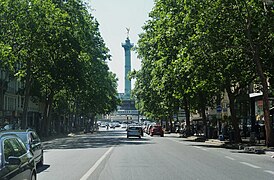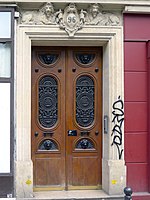Boulevard Beaumarchais
Coordinates: 48 ° 51 ′ 26 ″ N , 2 ° 22 ′ 5 ″ E
| Boulevard Beaumarchais | |
|---|---|
| location | |
| Arrondissement | 3rd , 4th and 11th arrondissement |
| Beginning | Place de la Bastille |
| The End | 2, Rue Saint-Sébastien and 1, Rue du Pont-aux-Choux |
| morphology | |
| length | 750 m |
| width | 35 m |
| history | |
| Start of planning | 1536 |
| inauguration | 1705 |
| Coding | |
| Paris | 0780 |
The Boulevard Beaumarchais [ bulvaʁ bomaʀˈʃɛ ] is the longest of the Grands Boulevards in Paris with a length of 750 meters and runs in the 3rd , 4th and 11th arrondissemements between the Place de la Bastille and the Boulevard des Filles-du-Calvaire .
Name origin
The traffic route was named after Pierre Augustin Caron de Beaumarchais (1732–1799; French businessman, musician , poet and dramaturge ). Beaumarchais is best known as a writer .
History of origin
Starting in 1668, Louis XIV had the northern Paris city walls removed, which were laid out under Charles V and under Louis XIII. had been extended to the west. The Boulevard Beaumarchais was one of the first to be commissioned on June 7, 1670 and had an 18 meter wide median. Under the direction of the architect Pierre Bullet , the so-called Nouveau Cours , an avenue of trees between the old city gates Porte Saint-Honoré (today Place de la Madeleine ) and the Porte Saint-Antoine at the Bastille, was laid out on the resulting open space . On the basis of the decree of the royal council of "Sun King" Louis XIV of June 7th, 1670, the "Boulevard de la Porte Saint-Antoine" and "Boulevard Bourdon" were to be built on the vacated wall area. In the Plan de Turgot from 1739, next to the rue des Tournelles, a tree-lined area leading from the Bastille can be seen, where the boulevard was to be built. Construction began on Porte Saint-Antoine, which was demolished in 1778. The wall surface was rounded off and created space for the 35 meter wide Boulevard Saint-Antoine .
Here - at the location of the street called "rue Jean Beau Sire" in a city view from 1676 - the writer Pierre Augustin Caron de Beaumarchais acquired a 1 hectare property on June 26, 1787, on which he built a magnificent three-story house in 1788 walled park designed by François-Joseph Bélanger . The property stretched from the Boulevard Saint-Antoine to the parallel rue Amelot . From here, Beaumarchais could watch the storming of the Bastille on July 14, 1789. At his request, he was buried in the garden of his house in May 1799. The property was demolished in 1818 for the construction of the Canal Saint-Martin , and Beaumarchai's remains were transferred to the Père-Lachaise cemetery . On the site of the feudal city palace, the city built a salt store for the salt transported on the nearby Canal Saint-Martin.
The streets "Boulevard de la Porte Saint-Antoine" and "Boulevard Bourdon" were merged in 1831 and were given the uniform name Boulevard Beaumarchais in honor of the writer on January 22, 1831 . The expansion work began on June 8, 1834, and the final completion took place by December 1835. It was only after 1848 that most of the residential buildings were completed here. In 1867 it was reported that there were residential houses on the extensive land belonging to the Beaumarchais estate.
Buildings
- At # 1 there is now an 1880-style building erected on the ruins of a building that was completely burned down in May 1871 during the Paris Commune .
- The manor of Pierre-Augustin Caron de Beaumarchais , to which the boulevard is dedicated, was located at number 2 on the corner of Boulevard Richard-Lenoir and at the entrance to Place de la Bastille at the beginning of the underground Canal Saint-Martin . The house was demolished in 1829 when the canal opened. Around 1850, buildings were erected on the site of the garden, stretching between Boulevard Beaumarchais and Rue Amelot from the corner of Boulevard Richard-Lenoir to No. 22.
- At house no. 2 there is the Guimard metro access to the Bastille stop , which was originally located in the Rue de Lyon and was relocated because of the construction of the Opéra Bastille . In 1978 it was declared a monument historique .
- The MK2 Bastille cinema is located at house number 4 . The building played a role in the 1960 film The Dissatisfied by Claude Chabrol . At the time, this was a restaurant that was one of the first in Paris to serve hamburgers.
- The manor Hôtel de Sagonne (also known as "Hôtel Mansart") with a garden is located in house number 23 .
- House number 25 is the Théâtre Beaumarchais .
- The Boulangerie-pâtisserie Beaumarchais , which is part of the Monument historique , is located in house no .
- House no. 72 plays a role in the film The Unsatisfied ( French Les Bonnes Femmes ) by Claude Chabrol : The heroines work in a shop for electrical appliances, "maison Belin anciennement Vainqueur" They have breakfast in the nearby restaurant (house no. 4) in today's MK2 Bastille .
- House number 91 has a balcony with hanging plants.
- Jean-François Heidenreich lived at number 96 .
- The "Hôtel de Cagliostro " is at number 99 (and 1, rue Saint-Claude ).
- The passage at # 109 leads to a "T" street.
- House no. 113 (and 1, rue du Pont-aux-Choux ) has been on the Monument historique list since 1925 .
- At the beginning of the French Revolution , Antoine Joseph Santerre ran a beer shop in house 176 .
No. 23, Hôtel de Sagonne .
99, the house of Cagliostro
No. 113, a monument
Location and importance
The very lively and busy Boulevard Beaumarchais is part of the Grands Boulevards (from east to west: Boulevard de la Madeleine , des Capucines , des Italiens , Montmartre , Poissonnière , Bonne-Nouvelle , Saint-Denis , Saint-Martin , du Temple , des Filles -du-Calvaire and Beaumarchais). The house numbers 1–31 are in the 4th , 31 to the end in the 3rd and the even numbers in the 11th arrondissement . The Place des Vosges is nearby, only separated by the parallel rue des Tournelles .
The boulevard can be reached via the metro stations Bastille , Chemin Vert or Saint-Sébastien - Froissart .
Others
literature
- Jacques Hillairet , Dictionnaire historique des rues de Paris , Paris, Éditions de Minuit , 1972, 1985, 1991, 1997, etc. (1st edition 1960), 1,476 pages, 2 volumes, ISBN 2-7073-1054-9 , oclc / 466966117
- Félix et Louis Lazare, fr: Dictionnaire administratif et historique des rues de Paris et de ses monuments .
- Jean de La Tynna, Dictionnaire topographique, étymologique et historique des rues de Paris , 1817.
Individual evidence
- ↑ Hildegard Schröteler-von Brandt, Stadtbau- und Urbanplanungsgeschichte , 2008, p. 78
- ↑ Janette C. Gatty, Beaumarchais sous la Révolution , 1976, p. 31
- ↑ Pierre Augustin Caron de Beaumarchais, Œuvres choisies de Beaumarchais , Volume 1, 1818, p. XXIX
- ↑ Adolphe Joanne, Paris-diamant: Neuer Führer , 1867, p. 68 ff.
- ↑ Pierre Pinon, Les canaux de Paris , Paris, Action artistique de la Ville de Paris, September 1994, 222 pp. ( Notice BnF no FRBNF36680623 ), “La maison Caron de Beaumarchais”, pp. 34-37
- ↑ a b Virginie Descure and Christophe Casazza, Ciné Paris. 20 strolls sur des lieux de tournages mythiques , Éditions Hors Collection, 2003, 167 pp., ISBN 2-258-06019-2 , p. 103
- ↑ http://www2.culture.gouv.fr/
- ↑ Isabelle Calabre, Paris d'en haut et d'en bas , p. 17, in Votre quartier sous la Révolution , Le Nouvel Obs Paris - Île-de-France , N. 2213, weekly edition of 5/11. April 2007, pp. 12-21




















